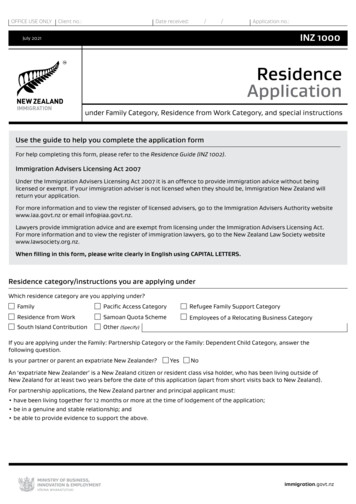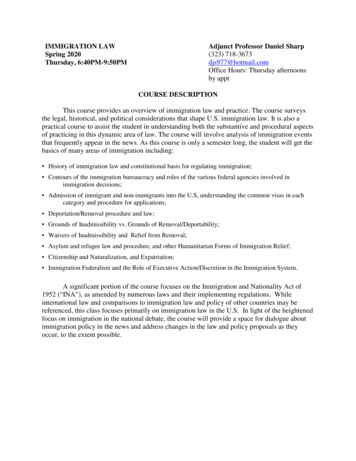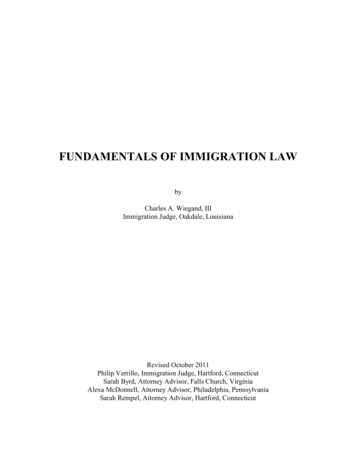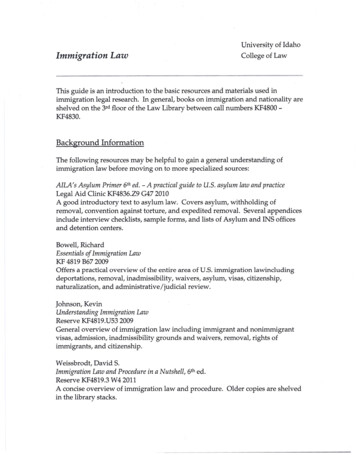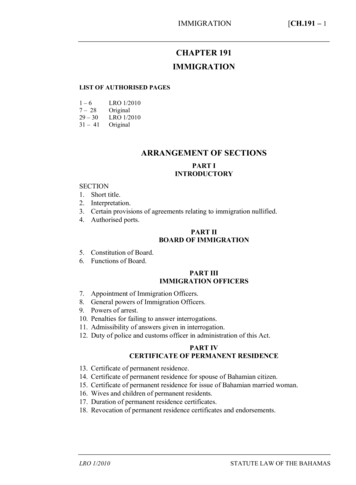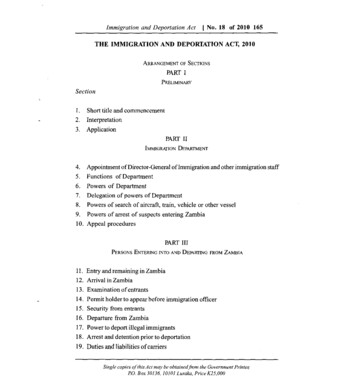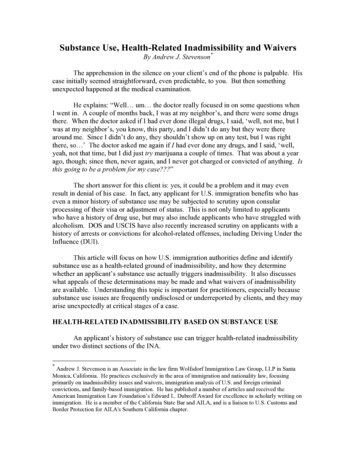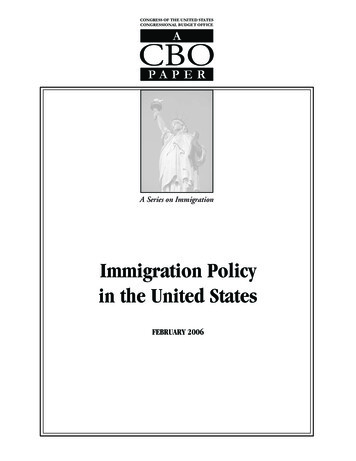
Transcription
rPublished since 2007U.S. Department of JusticeExecutive Office for Immigration ReviewImmigration Law AdvisorSeptember 2015A Legal Publication of the Executive Office for Immigration Review Vol. 9 No. 8In this issue.Page 1: Feature Article:Beyond the Record:Administrative Noticeand the OpportunityTo RespondPage 4: Federal Court ActivityPage 7: BIA Precedent DecisionsPage 8: Regulatory UpdateThe Immigration Law Advisor is aprofessional newsletter of the ExecutiveOffice for Immigration Review(“EOIR”) that is intended solely as aneducational resource to disseminateinformation on developments inimmigration law pertinent to theImmigration Courts and the Boardof Immigration Appeals. Any viewsexpressed are those of the authors anddo not represent the positions of EOIR,the Department of Justice, the AttorneyGeneral, or the U.S. Government. Thispublication contains no legal adviceand may not be construed to createor limit any rights enforceable bylaw. EOIR will not answer questionsconcerning the publication’s content orhow it may pertain to any individualcase. Guidance concerning proceedingsbefore EOIR may be found in theImmigration Court Practice Manualand/or the Board of ImmigrationAppeals Practice Manual.Beyond the Record: Administrative Notice and theOpportunity To Respondby Robyn Brown and Vivian CarballoImmigration courts are frequently faced with voluminous evidentiarysubmissions. However, whether the quantity of evidence in a case isvast or meagre, the court at times finds itself in a position of needingto consider evidence outside the record of proceedings to further analyze thematter at hand. To what extent does an Immigration Judge or the Boardof Immigration Appeals have the authority to do so? And for what typesof evidence is such consideration appropriate? What are the relevant dueprocess concerns related to administrative notice?This article will look at the practice of taking official notice of factsoutside the record, otherwise known as “administrative notice.” It willalso discuss case law related to the consideration of “judicial experience,”including awareness of inter-proceeding similarities. Finally, the article willexamine due process concerns related to administrative notice and brieflydescribe the circuit split as to whether parties must be given an opportunityto respond to administratively noticed facts before the court issues a decision.Administrative NoticeIt is well established that courts “take judicial notice of mattersof common knowledge.” See Ohio Bell Tel. Co. v. Public Utils. Comm’n ofOhio, 301 U.S. 292, 301 (1937). Administrative notice, which is officialnotice taken by administrative agencies, is very similar to judicial notice,but it is broader in scope. See de la Llana-Castellon v. INS, 16 F.3d 1093,1096 (10th Cir. 1994); Castillo-Villagra v. INS, 972 F.2d 1017, 1026 (9thCir. 1992) (“The appropriate scope of notice is broader in administrativeproceedings than in trials, especially jury trials.”). This breadth arises fromseveral different factors, including the fact that the Federal Rules of Evidencedo not apply in immigration proceedings. See, e.g., Matter of D-R-, 25 I&NDec. 445, 458 (BIA 2011). Additionally, the range of “commonly knownfacts” that can be officially noticed is more expansive in the administrativecontext given the repetitive nature of administrative proceedings and the1
agency’s specialized expertise in a certain area of subject that the asylum applicant was not deprived of due processmatter. See Castillo-Villagra, 972 F.2d at 1026; McLeod where the Immigration Judge introduced into evidence av. INS, 802 F.2d 89, 93 n.4 (3d Cir. 1986).United States governmental report on gangs in CentralAmerica and a State Department issue paper on gangsAuthority To Take Noticein El Salvador, and the applicant had an opportunity toexamine and respond to the documents. In OgayonneThe Board derives its authority to take v. Mukasey, 530 F.3d 514, 518–20 (7th Cir. 2008), theadministrative notice from 8 C.F.R. § 1003.1(d)(3)(iv), Seventh Circuit concluded that the Immigration Judgewhich provides that it may take administrative notice of did not err in admitting into the record documents“commonly known facts such as current events or the from his own Internet research, including Unitedcontents of official documents.” There is no analogous Nations articles, a BBC News article, and an Amnestyregulatory provision for Immigration Judges, but the International report. The court noted that the documentsBoard and circuit courts have recognized Immigration “merely stated commonly acknowledged facts that wereJudges’ ability to take administrative notice of certain types amenable to official notice,” that the Immigration Judgeof evidence. See, e.g., Vasha v. Gonzales, 410 F.3d 863, provided the parties with an opportunity to respond,874 n.5 (6th Cir. 2005) (explaining that administrative and that the applicant did not object to the admissionnotice is limited to commonly known facts or matters of the documents. The Seventh Circuit also noted thatwithin the Immigration Judge’s “expertise or experience it was “not particularly troubled by the [Immigrationin handling asylum claims”); Singh v. Ashcroft, 393 Judge’s] reliance on these documents because the relevantF.3d 903, 905–07 (9th Cir. 2004) (acknowledging “the information was independently included in other properlyordinary power of any court to take notice of facts that admitted evidence.” Id. at 520. In Kazlauskas v. INS,are beyond dispute”); Medhin v. Ashcroft, 350 F.3d 685, 46 F.3d 902, 906 n.4 (9th Cir. 1995), the Immigration690 (7th Cir. 2003) (stating that the Immigration Judge Judge sought two advisory opinions from the State“may take administrative notice of changed conditions in Department. The Ninth Circuit rejected the applicant’sthe alien’s country of origin”); Matter of Chen, 20 I&N argument that the Immigration Judge abused hisDec. 16, 18 (BIA 1989) (noting that the Immigration discretion in taking administrative notice of changedJudge or Board “may take administrative notice of changed country conditions, noting that the applicant had noticecircumstances in appropriate cases, such as where the and an opportunity to respond. Id.government from which the threat of persecution arises hasbeen removed from power”); see also 8 C.F.R. § 1003.36Several circuits have spoken regarding the(“The Immigration Court shall create and control the appropriateness of taking administrative notice of StateRecord of Proceedings.”). Moreover, adjudicators may Department Country Reports on Human Rights Practicesdraw reasonable inferences from administratively noticed (“Country Reports”) and Country Profiles. In Ying Chenevidence that “comport with common sense.” See Kapcia v. Attorney General of the U.S., 676 F.3d 112, 115 n.2v. INS, 944 F.2d 702, 705 (10th Cir. 1991) (quoting (3d Cir. 2011), the Third Circuit concluded that the BoardKaczmarczyk v. INS, 933 F.2d 588, 594 (7th Cir. 1991)). did not err in considering the Country Profile, even thoughit was not submitted into evidence. In Jian Hui ShaoCommonly Known Facts, Country Conditions,v. Mukasey, 546 F.3d 138, 166–68 (2d Cir. 2008), theand Official DocumentsSecond Circuit upheld the denial of relief where theBoard expanded the record to include more recentThe Board and Immigration Judges may take versions of the Country Report and Country Profile,administrative notice of current events and changed because the Board did not base its determination solely oncountry conditions. See, e.g., Yang v. McElroy, 277 F.3d administratively noticed facts. In contrast, in Qun Yang158, 163 n.4 (2d Cir. 2002); Meghani v. INS, 236 F.3d v. McElroy, 277 F.3d 158, 161–62 (2d Cir. 2002), the843, 847–48 (7th Cir. 2001). Several circuits have Board had affirmed an Immigration Judge’s determinationaddressed whether administrative notice may be taken of that the applicant’s fear of future persecution was notspecific types of documentary evidence related to country objectively reasonable, a finding based on a dated Countryconditions. In Constanza-Martinez v. Holder, 739 F.3d Report. The Second Circuit remanded the case to the1100, 1102–03 (8th Cir. 2014), the Eighth Circuit held Board for consideration of changed country conditions,2
noting that the record was “silent as to [the country’s]contemporary treatment of persons” in situations similarto the applicant’s. Id. at 163. In Francois v. INS, 283F.3d 926, 933 (8th Cir. 2002), the Eighth Circuit heldthat the Board properly took administrative notice of theCountry Reports for Eritrea where the alien was previouslyaware of evidence of changed country conditions. TheSeventh Circuit has warned, however, that adjudicatorsshould treat Country Reports with a “healthy skepticism”and not afford conclusive weight to statements in thereports that are contestable. Galina v. INS, 213 F.3d 955,958–59 (7th Cir. 2000).Judicial ExperienceThe extent to which Immigration Judges mayconsider “judicial experience” is an unresolved question.In Matter of Gomez-Gomez, 23 I&N Dec. 522, 525(BIA 2002), the Immigration Judge took administrativenotice of the former Immigration and NaturalizationService’s regional practice of releasing without bondadults accompanying juveniles, as well as her ownawareness of false claims of parentage. The Board statedthat it is unclear whether “any or all of these matterswould be deemed the type of ‘commonly acknowledged’fact of which administrative notice may legitimately betaken.” Id. at 525 n.2. The Sixth Circuit has indicatedthat Immigration Judges may consider commonlyknown facts or information derived from “institutionalexpertise” in hearing asylum claims. Vasha, 410 F.3d at874 n.5. However, it found that an Immigration Judgeimproperly relied on “extra-record knowledge” gleanedfrom an off-the-record conversation with her clerkregarding the respondent’s relationship with a prominentmember of the Albanian community. Id. (citing section240(c)(1)(A) of the Immigration and NationalityAct, 8 U.S.C. § 1229a(c)(1)(A) (“The determinationof the immigration judge [as to removability]shall be based only on the evidence produced at thehearing.”)).The Board may also take notice of “commonlyknown facts.” 8 C.F.R. § 1003.1(d)(3)(iv). Similarly,the Ninth Circuit found that it could take judicialnotice of recent dramatic political developments insome circumstances, explaining in one case that theadministrative record was “hopelessly out of date” andthat a recent coup in Fiji was “so troubling, so wellpublicized, and so similar to the earlier coups that [thecourt] would be abdicating [its] responsibility were [it]to ignore the situation.” Gafoor v. INS, 231 F.3d 645,654–57, 664 (9th Cir. 2000), superseded by statute on othergrounds by REAL ID Act of 2005, Division B of Pub.L. No. 109-13, 119 Stat. 302. While Gafoor addressedthe Ninth Circuit’s authority to take judicial notice ofthis development, it arguably indicates that similar eventsconstitute “commonly known facts” of which the Boardand Immigration Judges may take administrative notice.See, e.g., Quinn v. Robinson, 783 F.2d 776, 797 n.18(9th Cir. 1986) (noting that “courts generally will takejudicial notice of a state of uprising”).The Ninth Circuit has stated that “judicialexperience combined with obvious warning signs offorgery, when articulated on the record, may satisfy thesubstantial evidence requirement” to sustain an adversecredibility finding. Dao Lu Lin v. Gonzales, 434 F.3d1158, 1164 (9th Cir. 2006) (citing Bropleh v. Gonzales,428 F.3d 772, 777 (8th Cir. 2005)). In Bropleh,the Eighth Circuit upheld an Immigration Judge’sdetermination that a passport was purposely altered wherethe Immigration Judge “stated he had reviewed ‘hundreds’of passports, and was familiar with the precise place astamp concerning a visa application would be placed.”428 F.3d at 777. Taking Bropleh into consideration, theNinth Circuit found that an adverse credibility findingwas not supported by substantial evidence where theImmigration Judge found three documents “suspicious”but failed to indicate whether her suspicions were basedon her review of numerous other documents purportedlyThe outer limits of what constitutes an “officialdocument” under 8 C.F.R. § 1003.1(d)(3)(iv) has not beendefined by the Board or circuit courts, but the Fifth Circuitconcluded that the Board has “wide latitude” to take noticeof official documents, including its own files and records.Enriquez-Gutierrez v. Holder, 612 F.3d 400, 410–11 (5th Cir.2010) (holding that the Board did not abuse its discretion intaking administrative notice of transcripts from the applicant’sprior proceedings where the applicant did not challenge theirauthenticity). The Second Circuit has also taken a broadview, finding that a State court decision disbarring an asylumapplicant’s counsel was an “official document” under 8 C.F.R.§ 1003.1(d)(3)(iv) and was “too important [for the Board]to ignore” when adjudicating an ineffective assistance ofcounsel claim. Yi Long Yang v. Gonzales, 478 F.3d 133,142–43 (2d Cir. 2007).Continued on page 103
FEDERAL COURT ACTIVITYCIRCUIT COURT DECISIONS FOR AUGUST 2015by John GuendelsbergerTrelocation, and a frivolous claim. The eight reversalsor remands in the “other relief ” category addressed thecategorical approach (six cases), crimes involving moralturpitude, and adjustment of status. The three motionscases involved changed country conditions (two cases)and ineffective assistance of counsel.he United States courts of appeals issued 131decisions in August 2015 in cases appealed fromthe Board. The courts affirmed the Board in115 cases and reversed or remanded in 16, for an overallreversal rate of 12.2%, compared to last month’s 13.9%.There were no reversals from the First, Fourth, Fifth,Seventh, Tenth, and Eleventh Circuits.The chart below shows the combined numbers forJanuary through August 2015 arranged by circuit fromhighest to lowest rate of reversal.The chart below shows the results from each circuitfor August 2015 based on electronic database reports ofpublished and unpublished decisions.TotalAffirmedReversed% ReversedCircuitTotalAffirmedReversed% llLast year’s reversal rate at this point (Januarythrough August 2014) was 15.1%, with 1539 totaldecisions and 233 reversals or remands.The 131 decisions included 61 direct appealsfrom denials of asylum, withholding, or protection underthe Convention Against Torture; 42 direct appeals fromdenials of other forms of relief from removal or fromfindings of removal; and 28 appeals from denials ofmotions to reopen or reconsider. Reversals within eachgroup were as follows:Total Affirmed ReversedThe numbers by type of case on appeal for the first8 months of 2015 combined are indicated below.Total Affirmed Reversed% ReversedAsylum615658.2Other Relief4234819.0Motions2825310.7% ReversedAsylum5884979115.5Other Relief3172655216.4Motions262237259.5John Guendelsberger is a Member of the Board ofThe five reversals or remands in asylum cases Immigration Appeals.involved particular social group (two cases), nexus,4
RECENT COURT OPINIONSEighth Circuit:Shoyombo v. Lynch, No. 14-2649, 2015 WL 5084623(8th Cir. Aug. 28, 2015): The Eighth Circuit dismissed apetition for review of the Board’s denial of the petitioner’smotion to reopen proceedings sua sponte. The courtnoted the petitioner’s acknowledgment that the applicablestatute allowed for only one motion to reopen, and thathe had therefore asked the Board to consider his thirdmotion under its sua sponte authority. In declining to doso, the Board concluded that the record (which includedextensive evidence of fraud by the petitioner) did notestablish an “exceptional situation” warranting sua spontereopening. The petitioner argued that the Board’s decisionwas not “reasoned” and failed to consider his argumentconcerning ineffective assistance of counsel. However,because the petitioner’s motion and the Board’s decisionwere based exclusively on the Board’s sua sponte authorityunder 8 C.F.R. § 1003.2(a), the court held that it lackedjurisdiction to review the denial of the motion. The courtnoted that its holding in this respect is consistent with theposition of 10 other circuits.First Circuit:Xin Qiang Liu v. Lynch, No. 14-1159, 2015 WL 5306451(1st Cir. Sept. 11, 2015): The First Circuit denied apetition for review challenging the Board’s denial of amotion to reopen removal proceedings. The petitionerwas ordered removed in absentia when he did not appearfor his hearing in 1998. His subsequent motion toreopen was denied by the Immigration Judge the sameyear. Almost 14 years later, the petitioner filed a secondmotion to reopen, alleging both ineffective assistanceof prior counsel and changed conditions related tohis 2011 conversion to Christianity, which he arguedwarranted reopening to allow him to apply for asylum.The Immigration Judge denied the motion and the Boarddismissed the petitioner’s subsequent appeal. The FirstCircuit concluded that the respondent’s motion based onthe alleged ineffective assistance of counsel was untimelybecause a motion to reopen based on “exceptionalcircumstances” must be made within 180 days. The courtfurther concluded that it lacked jurisdiction to considerthe petitioner’s claim that the filing deadline shouldhave been equitably tolled since that argument was notdeveloped in his opening brief. Although no such timelimit on filing applies where reopening is sought to applyfor asylum arising from changed circumstances in thecountry of origin, the court relied on prior precedentin holding that changed personal circumstances such asa religious conversion will not, by themselves, establishchanged country conditions. The court agreed with theBoard’s conclusion that the petitioner had not otherwiseestablished a change in country conditions that wouldwarrant reopening proceedings. It specifically cited to theImmigration Judge’s comparison of the 1998 and 2009State Department Country Reports on China as evidencethat the mistreatment of unauthorized Christian groupsis indicative of a continuation of previous policies, ratherthan an increase in religious persecution. The court wasunpersuaded that the Immigration Judge and the Boarderred in not referencing particular documents that thepetitioner had submitted. Finding nothing in the record tosuggest any of the petitioner’s evidence had been disregarded,the court quoted Raza v. Gonzales, 484 F.3d 125, 128(1st Cir. 2007), for its conclusion that the ImmigrationJudges and the Board are “not required to dissect inminute detail every contention that a complaining partyadvances.”Ninth Circuit:Quijada-Aguilar v. Lynch, No. 12-70070, 2015 WL5103038 (9th Cir. Sept. 1, 2015): The Ninth Circuitgranted a petition for review from the Board’s removalorder. The petitioner was convicted in 1992 of voluntarymanslaughter in violation of section 192(a) of theCalifornia Penal Code. The Board found his offenseto be a categorical crime of violence under 18 U.S.C.§ 16(b) and therefore an aggravated felony under section101(a)(43)(F) of the Act. As a result, the petitioner wasineligible to apply for withholding of removal undersection 241(b)(3). Ninth Circuit precedent stated thatto be a crime of violence under 18 U.S.C. § 16(b), “theunderlying offense must require proof of an intentional useof force or a substantial risk that force will be intentionallyused during its commission.” However, the CaliforniaSupreme Court held that a person could be convictedof voluntary manslaughter under section 192(a) for“reckless” conduct. The Ninth Circuit concluded thatthe State statute encompasses a broader range of conductthan that described in 18 U.S.C. § 16 and therefore doesnot categorically fall within the definition of a crime ofviolence. Consequently, it found that the petitioner wasnot statutorily barred from withholding of removal. TheGovernment argued that case law requiring the intentionaluse of force at the time of the petitioner’s convictionshould govern in this case. The court disagreed, noting5
that the California Supreme Court held in People v. Lasko,999 P.2d 666 (Cal. 2000), that an intent to kill was neveran element of voluntary manslaughter and that priorholdings to the contrary were “fleeting observations” and“mere dictum.” As a result, the Ninth Circuit determinedthat the Lasko decision did not alter the elements ofthe crime but rather “set forth the law as it always was,including at the time of Quijada-Aguilar’s conviction in1992.” The court also directed the Board to reconsideron remand the petitioner’s claim for deferral of removalunder the Convention Against Torture, a claim based onthe past experiences of his family, which the Board hadconsidered waived.Acosta-Olivarria v. Lynch, No. 10-70902, 2015 WL5023955 (9th Cir. Aug. 26, 2015): The Ninth Circuitgranted a petition for review of the Board’s decisiondenying the petitioner’s application for adjustment ofstatus pursuant to Matter of Briones, 24 I&N Dec. 355(BIA 2007). In Briones, the Board concluded that alienswho are inadmissible under section 212(a)(9)(C)(i)(I) ofthe Act as the result of having been in unlawful status inthe United States for more than 1 year are not eligiblefor adjustment of status under section 245(i) of the Act.However, at the time that the petitioner’s application wasfiled, the petitioner was eligible for adjustment pursuantto the Ninth Circuit decision in Acosta v. Gonzales, 439F.3d 550 (9th Cir. 2006) (overruled by the en banc courtin 2012). Relying on the holding in Acosta then in effect,an Immigration Judge granted the adjustment applicationin December 2006. The Department of HomelandSecurity appealed. During the pendency of the appeal,the Board issued its decision in Briones, and remanded therecord to the Immigration Judge, who denied adjustmentpursuant to the new precedent. In a split panel decision,the Ninth Circuit found that the petitioner reasonablyrelied on Acosta at the time of filing. The court furtherheld that under the retroactivity analysis set forth inMontgomery Ward & Co., Inc. v. Federal Trade Commission,691 F.2d 1322 (9th Cir. 1982), the holding in Brionesshould not apply retroactively to bar the petitioner’sadjustment application. The court determined that thepetitioner’s “reliance interests and the burden retroactivitywould impose on him outweighed the interest in uniformapplication of the immigration laws.” The court thereforeremanded with instructions to reinstate the ImmigrationJudge’s 2006 grant of adjustment. The decision containsa dissenting opinion.Andrade v. Lynch, No. 12-70803, 2015 WL 5040202 (9thCir. Aug. 27, 2015): The Ninth Circuit denied a petitionfor review of the Board’s denial of deferral of removalto El Salvador under the Convention Against Torture.The petitioner argued that the Board did not properlyconsider the country conditions evidence of record or hisargument that he would likely face torture upon returnto El Salvador because his tattoos would cause him to belabeled as a gang member. Although the record did notcontain a photo of the tattoos, which the petitioner saidincluded his initials and those of his girlfriend, the courtobserved that they were decorative and not gang related.The court noted that the petitioner was found not to bea former gang member during the proceedings below.According to the court, the Board had given “extensiveand careful consideration” to the country materials in therecord, and substantial evidence supported its conclusionthat the evidence did not establish a likelihood that thepetitioner faced a probability of mistreatment rising tothe level of torture upon return to El Salvador. The courtdistinguished these facts from those in Cole v. Holder, 659F.3d 762 (9th Cir. 2011). In Cole, the court remandedwhere the record established that the petitioner’s tattooswere specifically associated with the Crips gang and, perexpert testimony, would cause the petitioner to have agreater than 75 percent risk of being killed in his homecountry. The court clarified that Cole did not establishthat any type of tattoo would be enough to justifyprotection under the Convention Against Torture. Thecourt held that substantial evidence supported the Board’sconclusion that the petitioner had not established alikelihood of torture upon return to El Salvador, giventhat he was not a former gang member and did not havegang tattoos.Acevedo v. Lynch, No. 12-71237, 2015 WL 4999292(9th Cir. Aug. 24, 2015): The Ninth Circuit denied apetition for review of the Board’s decision affirming anImmigration Judge’s determination that the petitionerhad not derived citizenship through his stepfather. Thepetitioner was born in Mexico in 1987. His mothermarried a United States citizen when the petitioner was12 years old, and he was admitted to this country 2 yearslater as a lawful permanent resident based on a visa petitionfiled on his behalf by his stepfather. The petitioner wasplaced in removal proceedings following a 2008 domesticviolence conviction. Both the Immigration Judge andthe Board rejected the petitioner’s argument that he6
had derived citizenship through his stepfather undersection 320(a) of the Act, 8 U.S.C. § 1431(a), finding itto be inconsistent with the Board’s holding in Matter ofGuzman-Gomez, 24 I&N Dec. 824 (BIA 2009). Notingthat it does not owe deference to the Board’s interpretationsof citizenship laws, the Ninth Circuit nevertheless agreedwith the Board. In Guzman-Gomez, the Board found itsignificant that Congress had included a “stepchild” inits definition of the term “child” under section 101(b)of the Act, 8 U.S.C. § 1101(b), which applies to allimmigration provisions of the Act except citizenship, butthat stepchildren were not included in the definition of a“child” in section 101(c) (which applies to the citizenshipand naturalization provisions of the Act only). Findingthat the negative inference drawn from the differingstatutory language might not be conclusive, the court wasalso persuaded by the Board’s consideration of legislativehistory from the 1952 McCarren-Walter Act, which wasthe first version of the Immigration and Nationality Act.The Board specifically relied on a Senate subcommitteereport stating that the proposed legislation did not intendto change existing law relating to derivative citizenshipunder which “[s]tepchildren do not derive citizenshipthrough the naturalization of a stepparent.” The courtacknowledged that the facts in the petitioner’s case weredistinguishable since his stepfather had not become anaturalized citizen after his marriage to the petitioner’smother but was already a citizen at the time of the marriage.The court was not persuaded that this difference affectedits analysis and found the legislative history sufficient toestablish that the omission of a “stepchild” from section101(c) of the Act “was purposeful.” The court alsorejected the petitioner’s argument (which was not raisedin Guzman-Gomez) that the reference in section 320(b)of the Act to adopted children, as defined in section101(b)(1), should be viewed as implicitly incorporatingall of section 101(b)(1)’s definitions of a child into therequirements for citizenship in section 320(a) of the Act.Applying the same negative inference employed above,the court concluded that Congress’ choice not to includea reference to section 101(b)(1) of the Act in section320(a) signaled its intent that citizenship matters shouldbe governed by the Act’s “default definition” in section101(c), which does not mention “stepchildren.” Further,the references to provisions for adopted children wouldnot apply to the petitioner, who was never adopted. Lastly,the court found that the purpose of section 320 (whichwas to streamline foreign adoptions) did not support thepetitioner’s interpretation.BIA PRECEDENT DECISIONSIn Matter of M-A-F-, 26 I&N Dec. 651 (BIA2015), a case on remand from the United StatesCourt of Appeals for the Ninth Circuit, the Boardconsidered the controlling filing date for purposes ofdetermining if an asylum application was timely filedand whether it is subject to the provisions of the REALID Act of 2005, Division B of Pub. L. No. 109-13, 119Stat. 302 (“REAL ID Act”), when the alien has submittedmore than one application.Noting that 8 C.F.R. §§ 208.4(c) and 1208.4(c)permit the amendment or supplementation of an asylumapplication, the Board reasoned that the determinationwhether the REAL ID Act applies hinges on whether alater application presents a new claim or is an amendmentor supplement to the original application. The Boardexplained that in making such a determination, thespecific facts and circumstances of each filing must beexamined. If the later application presents a claim forrelief that was not previously raised or is predicated ona new or substantially different factual basis, it generallywill be considered a new application. In contrast, if thesubsequent application merely clarifies or slightly altersthe original, it will not be considered to be new. TheBoard held that where an initial asylum applicationwas filed prior to May 11, 2005, and a subsequent onesubmitted on or after that date, if the later application isproperly viewed as a new one, the later date is deemed tobe the filing date for purposes of applying the REAL IDAct provisions to credibility determinations.In the case at hand, the respondent filed his firstasylum application in February 2003 and then a secondapplication in May 2006, after the enactment of theREAL ID Act. He admitted that the initial applicationcontained a false narrative. Even though the 2
The extent to which Immigration Judges may consider "judicial experience" is an unresolved question. In Matter of Gomez-Gomez, 23 I&N Dec. 522, 525 (BIA 2002), the Immigration Judge took administrative notice of the former Immigration and Naturalization Service's regional practice of releasing without bond
